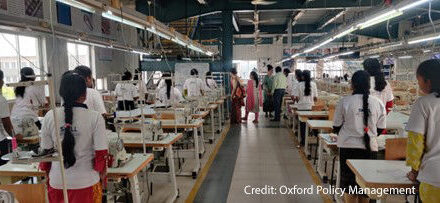This blog was written by Amna Javed and Maham Afzal, Idara-e-Taleem-o-Aagahi (ITACEC).
As the world goes through shifting weather patterns, rising sea levels, and increasingly cataclysmic disasters, climate resilience has become a matter of human rights and is the only recourse that must be resorted to. In this critical milieu, it is thus imperative to leverage education for climate change advocacy and cultivate eco-conscious mindsets for a better, sustainable future.
In this blog, we undertake a multidimensional analysis, discussing the definitional nuances of climate-smart education, assessing its role in fostering climate literacy and resilience, and scrutinising the challenges plaguing the current educational landscape. Additionally, we offer a set of policy recommendations, especially for low-income countries, that can be employed to empower policy-makers, educators, and students alike to combat climate change proactively.
With its effects extending from fluctuating ecosystems to threatening global food security, climate change is one of the main challenges plaguing this era. Amidst the need for various sector-wise solutions, a central aspect of the role of education in building climate resilience remains understated. Climate resilience essentially involves assessing how climate change can create new or alter the current climate-related risks, and ultimately taking steps to better cope with these risks, while inflicting the least amount of damage to humans as well as the environment.
Climate-smart education systems
This introduces us to the concept of climate-smart education systems. Climate-smart education is not just an educational approach but a rounded response to the education and climate crises; a paradigm shift in the way we educate and prepare the next generation. It integrates climate change knowledge, skills, and resilience-building into formal and informal education systems.
The Global Partnership for Education (GPE) defines a climate-smart education system that “ultimately works to achieve three interrelated goals: protecting and advancing quality, relevant and equitable education, protecting the planet’s life systems, and promoting climate justice.”
But why is climate-smart education significant, especially in the context of a changing climate?
Climate-smart education emerges as a linchpin and is not just about imparting knowledge; it is about fostering a generation that is equipped to tackle the challenges of a changing world. GPE created a framework that aligns with the current landscape of climate-resilient education systems, applicable to Global North countries, but also tailored for the Global South. The framework delineates seven facets of this education system that should be viewed as interconnected, as one facet cannot be sustained in isolation.
In terms of the education sector, there is an emphasis on advocating for a more climate-oriented education system. According to Article 6 of the United Nations Framework Convention on Climate Change (UNFCCC), nations are obliged to create and execute programmes that educate the public about climate change and its consequences. This commitment to education’s vital role in bolstering climate action is reaffirmed in Article 12 of the Paris Climate Agreement Top of Form. This reiterates the idea of creating climate-resilient education approaches and for nations to find system-based solutions to the challenges and vulnerabilities they face.
Across the globe, the educational infrastructure has been rendered vulnerable to the wrath of a changing climate. In Bangladesh, a country highly vulnerable to flooding and cyclones, as a response, various interventions and policies were introduced such as: ‘Solar Powered Floating Schools’, the National Education Policy 2010 which includes a broad climate-change focused education, Minimum Standards for Education in Emergencies, and many others.
As the climate crisis escalates, there persists a glaring gap in climate change knowledge among students and educators alike. In Sweden, however, the significance of climate change education was underscored by a study conducted by the Swedish Environmental Protection Agency. It revealed that while Swedish students recognised climate change as a crucial issue, many had limited knowledge about its causes and consequences. The government responded by integrating comprehensive climate change education into the school curricula, emphasising the need for students to understand the science behind climate change and its societal implications.
However, such initiatives remain exceptional. Globally, a majority of students receive fragmented or inadequate climate change education. This knowledge gap perpetuates climate myths and misconceptions and hinders informed decision-making
A recent study undertaken in Pakistan developed an assessment tool by integrating climate resilience indices and incorporating the 16 tasks outlined in the Hyogo Framework for Action to understand education sector resilience in the country. Results showed a significant correlation between human resources and institutional issues, as well as between institutional issues and external relationships. This reveals that enhancing institutional matters has the potential to boost both human resources and external relationships. Additionally, the connection between institutional issues and external relationships suggests that improving institutions can also lead to improvements in external relationships.
Regarding school curriculum integration, there are two main approaches: one promotes cross-disciplinary integration, weaving climate change education into various subjects, while the other, less common approach involves embedding it in non-disciplinary or interdisciplinary contexts, often through projects or thematic initiatives. Integrating environmental education into other subjects combines knowledge, skills, attitudes, and values from single or multiple disciplines to create a comprehensive understanding of core concepts.
Similar to the case in Sweden, a case study from Pondicherry, India, also showed encouraging results in students’ cognitive, affective, and behavioural development about environmental sustainability when a module on biodiversity was introduced that consisted of three constructs: didactic, conceptual, and technological. Findings showed that the module had a positive impact on how students interacted with the environment outside their classrooms and eventually their communities and homes. The use of active learning strategies in pedagogy showed a significant boost in student learning and therefore, such methodologies can play a significant role in climate-resilient curricula.
It is also crucial to note that modes of environmental and climate change education integration will vary in different contexts. Cross-disciplinary integration may not always be suitable, and teachers might face challenges in balancing subject priorities. Therefore, granting educators flexibility in the classroom is the best approach, hence enabling them to adapt to their specific contexts. It is important to mention here that encouraging teacher agency and experimentation, also enhances the sustainability of the model as teachers are intrinsically motivated toward the shared goal.
Incorporating climate change education into curricula alone does not offer a definitive solution. In reality, those responsible for imparting knowledge and skills should also possess the readiness and capability to embrace, adapt to, and effectively implement the curricular changes. Cultivating cognitive frameworks attuned to climate resilience necessitates a substantial capacity for complex problem-solving and rapid cognitive adaptation among teachers as well. This often results in a gap in teacher education and professional development, an area often overlooked. Empirical evidence emphasises the significance of comprehensive training for both pre-service and in-service teachers, covering content knowledge and pedagogy when it comes to climate change and environmental education.
A longitudinal research conducted by Boeve-de Pauw et al, underscores the significance of implementing a gradual, extended strategy for teacher professional development in Education for Sustainable Development, taking into account the unique context of schools and the requirements of school staff. Results showed that the obstacles faced by educators involved the integration of interdisciplinary methods, assessing student progress, and engaging in partnerships with community stakeholders.
Policy recommendations
As we strive for an education system resilient to climate challenges, a strong policy framework emerges as the fundamental foundation of our ambitions. These recommendations can serve as a guide to navigating the difficult terrain of climate change and education, enabling us to shape our educational institutions into strongholds of climate resilience.
For countries like Pakistan, there is a need for comprehensive national policies explicitly mandating climate-smart education, which is core to this transformative idea. Advocating for these policies constitutes a pivotal stride towards nurturing an environmentally-conscious generation equipped not only with knowledge but also with the proficiencies required to confront climate change. Policymakers need to prioritise adaptability over rigidity, cultivating an environment where climate-smart education is universally accessible and not just a privilege. This is a pertinent point that the policy-making bodies in Pakistan need to be aware of.
At the heart of translating policy intentions into actionable outcomes stands the need for robust financing. Adequate and consistent funding is essential, shielding under-resourced educational institutions, ensuring access to climate-smart education, and bridging economic disparities. Integrating sound fiscal strategies in policy-making structures in these tumultuous economic times in Pakistan thus becomes a necessity. Investments dedicated to professional development must take a central role, equipping educators with the necessary knowledge and skills for effective climate education delivery. A crucial part of this is the strategic allocation of resources for curriculum development. This, essentially, enables the development of educational materials that are informative, engaging, contextually relevant, and responsive to the evolving needs of modern learners.
The endeavour to achieve climate resilience in education demands collaboration among various stakeholders. This collaboration must mobilise governmental entities, educational institutions, non-governmental organisations, and the private sector, each leveraging its unique strengths and resources to contribute to climate resilience in education.
In our exploration of climate-smart education systems, closing the knowledge gap between students and educators is critical for ushering in climate advocacy and environmental sustainability. Mandating adaptable and inclusive climate-smart education through national policies and facilitating collaborations across governments, institutions, NGOs, and the private sector are potential catalysts for transformative change. There is a dire need to redirect our existing infrastructure to adopt a more holistic approach, reimagining building blocks such as organisational structures, curricula, and teacher professional development. Thus, building climate-smart and resilient education systems is an imperative that transcends traditional boundaries, preparing the youth not only for academic excellence but also for the challenges of a dynamic, climate-altered world.





